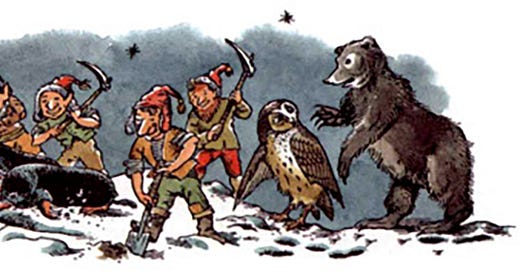The Silver Chair: Chapter 15 “The Disappearance of Jill”
C.S. Lewis Read-Along, Vol. 4, Issue 16
Background: Regardless of their surroundings and outward appearances, there is something obvious and unmistakably evident on those who follow God’s will. It is reflected glory.
Quote:
“‘And the lesson of it all is, your Highness,’ said the oldest Dwarf, ‘that those Northern Witches always mean the same thing, but in every age they have a different plan for getting it.’”
Much like the last chapter gave us a different perspective on the same event (hearing how the gnomes responded to the Witch’s death), this chapter opens with a similar but shorter exploration of two different viewpoints.
Jill climbs up Puddleglum and looks out through the hole in the underworld roof. Just as she’s about to relay down what she sees, her voice is muffled, and she’s pulled up and through the hole.
Down in the digging, Puddleglum, Rilian, and Eustace immediately assume she’s been taken by enemies or other cave-dwelling creatures. Eustace lashes out at Puddleglum and asks why the marshwiggle didn’t hold on to Jill tighter. Puddleglum blames both fate and himself, tying back to eating the talking stag at Harfang. Rilian says this is the “greatest shame and sorrow that could have fallen on us.” Meanwhile, Jill is having quite a different experience.
We discussed how The Silver Chair serves as an exploration of Plato’s allegory of the cave and the importance of perspective. The three still in the cave have a limited perspective and can only assume malevolent forces have taken Jill. But she has escaped the cave and gained more knowledge.
Throughout his writing, Lewis often explored the idea of perspective and how we gain knowledge. One of his most famous essays, “Meditation in a Toolshed,” points out two ways of learning by looking at and looking along. He says that looking at, examining something from the outside, has been prioritized to the point of excluding any other perspective.
Lewis effectively argues that looking at is helpful but incomplete. “We must, on pain of idiocy, deny from the very outset the idea that looking at is, by its own nature, intrinsically truer or better than looking along,” he writes. “One must look both along and at everything.”
The three are only able to look at Jill being pulled through the hole, but Jill was able to look along the light coming through and see the world outside. They had actually arrived in Narnia and during one of Lewis’ favorite images, a dance.1
Keep reading with a 7-day free trial
Subscribe to The Wardrobe Door to keep reading this post and get 7 days of free access to the full post archives.





